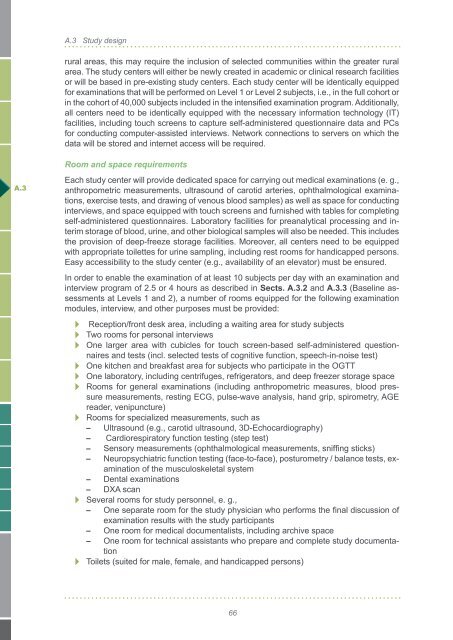Scientific Concept of the National Cohort (status ... - Nationale Kohorte
Scientific Concept of the National Cohort (status ... - Nationale Kohorte
Scientific Concept of the National Cohort (status ... - Nationale Kohorte
Create successful ePaper yourself
Turn your PDF publications into a flip-book with our unique Google optimized e-Paper software.
A.3<br />
A.3 Study design<br />
rural areas, this may require <strong>the</strong> inclusion <strong>of</strong> selected communities within <strong>the</strong> greater rural<br />
area. The study centers will ei<strong>the</strong>r be newly created in academic or clinical research facilities<br />
or will be based in pre-existing study centers. Each study center will be identically equipped<br />
for examinations that will be performed on Level 1 or Level 2 subjects, i.e., in <strong>the</strong> full cohort or<br />
in <strong>the</strong> cohort <strong>of</strong> 40,000 subjects included in <strong>the</strong> intensified examination program. Additionally,<br />
all centers need to be identically equipped with <strong>the</strong> necessary information technology (IT)<br />
facilities, including touch screens to capture self-administered questionnaire data and PCs<br />
for conducting computer-assisted interviews. Network connections to servers on which <strong>the</strong><br />
data will be stored and internet access will be required.<br />
Room and space requirements<br />
Each study center will provide dedicated space for carrying out medical examinations (e. g.,<br />
anthropometric measurements, ultrasound <strong>of</strong> carotid arteries, ophthalmological examinations,<br />
exercise tests, and drawing <strong>of</strong> venous blood samples) as well as space for conducting<br />
interviews, and space equipped with touch screens and furnished with tables for completing<br />
self-administered questionnaires. Laboratory facilities for preanalytical processing and interim<br />
storage <strong>of</strong> blood, urine, and o<strong>the</strong>r biological samples will also be needed. This includes<br />
<strong>the</strong> provision <strong>of</strong> deep-freeze storage facilities. Moreover, all centers need to be equipped<br />
with appropriate toilettes for urine sampling, including rest rooms for handicapped persons.<br />
Easy accessibility to <strong>the</strong> study center (e.g., availability <strong>of</strong> an elevator) must be ensured.<br />
In order to enable <strong>the</strong> examination <strong>of</strong> at least 10 subjects per day with an examination and<br />
interview program <strong>of</strong> 2.5 or 4 hours as described in Sects. A.3.2 and A.3.3 (Baseline assessments<br />
at Levels 1 and 2), a number <strong>of</strong> rooms equipped for <strong>the</strong> following examination<br />
modules, interview, and o<strong>the</strong>r purposes must be provided:<br />
� Reception/front desk area, including a waiting area for study subjects<br />
� Two rooms for personal interviews<br />
� One larger area with cubicles for touch screen-based self-administered questionnaires<br />
and tests (incl. selected tests <strong>of</strong> cognitive function, speech-in-noise test)<br />
� One kitchen and breakfast area for subjects who participate in <strong>the</strong> OGTT<br />
� One laboratory, including centrifuges, refrigerators, and deep freezer storage space<br />
� Rooms for general examinations (including anthropometric measures, blood pressure<br />
measurements, resting ECG, pulse-wave analysis, hand grip, spirometry, AGE<br />
reader, venipuncture)<br />
� Rooms for specialized measurements, such as<br />
– Ultrasound (e.g., carotid ultrasound, 3D-Echocardiography)<br />
– Cardiorespiratory function testing (step test)<br />
– Sensory measurements (ophthalmological measurements, sniffing sticks)<br />
– Neuropsychiatric function testing (face-to-face), posturometry / balance tests, examination<br />
<strong>of</strong> <strong>the</strong> musculoskeletal system<br />
– Dental examinations<br />
– DXA scan<br />
� Several rooms for study personnel, e. g.,<br />
– One separate room for <strong>the</strong> study physician who performs <strong>the</strong> final discussion <strong>of</strong><br />
examination results with <strong>the</strong> study participants<br />
– One room for medical documentalists, including archive space<br />
– One room for technical assistants who prepare and complete study documentation<br />
� Toilets (suited for male, female, and handicapped persons)<br />
66



